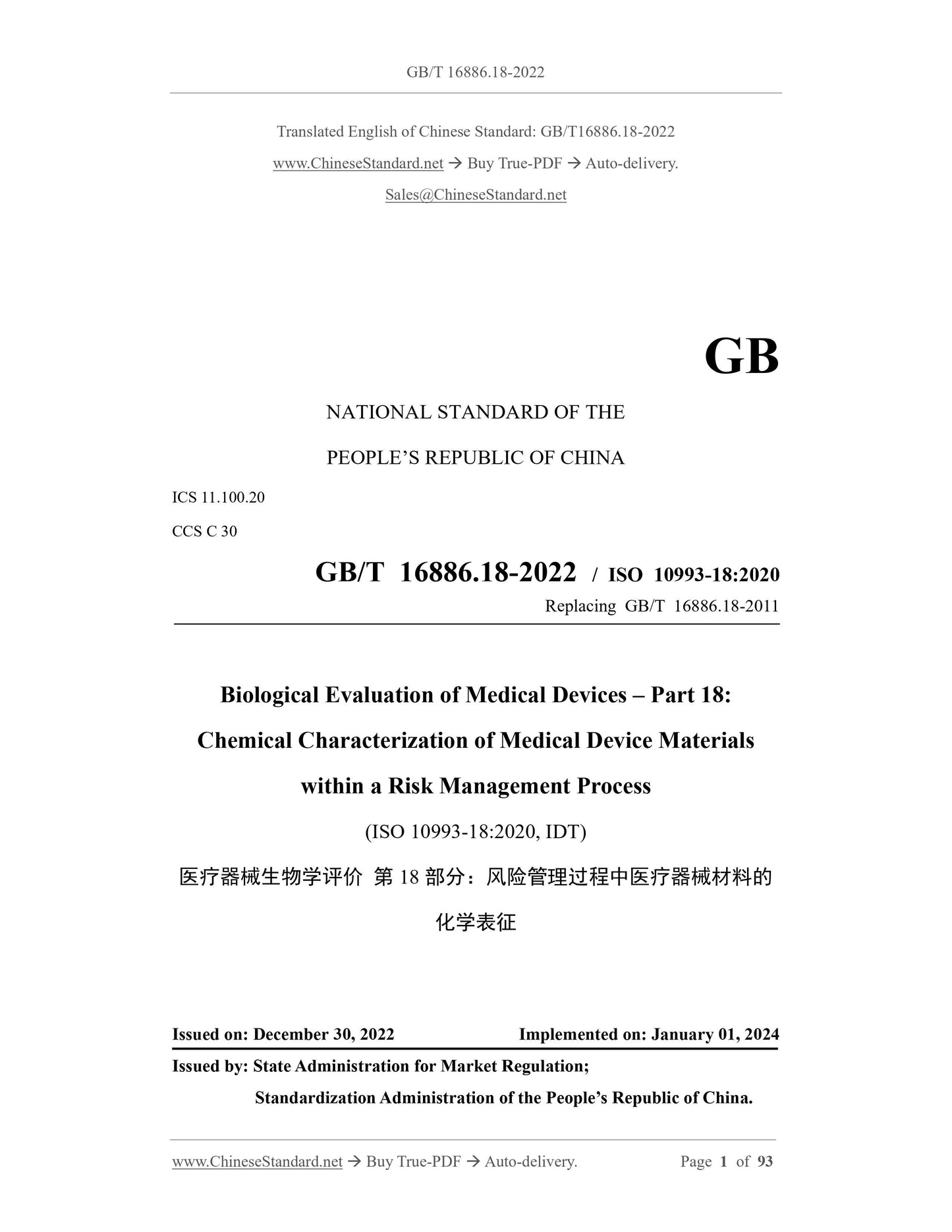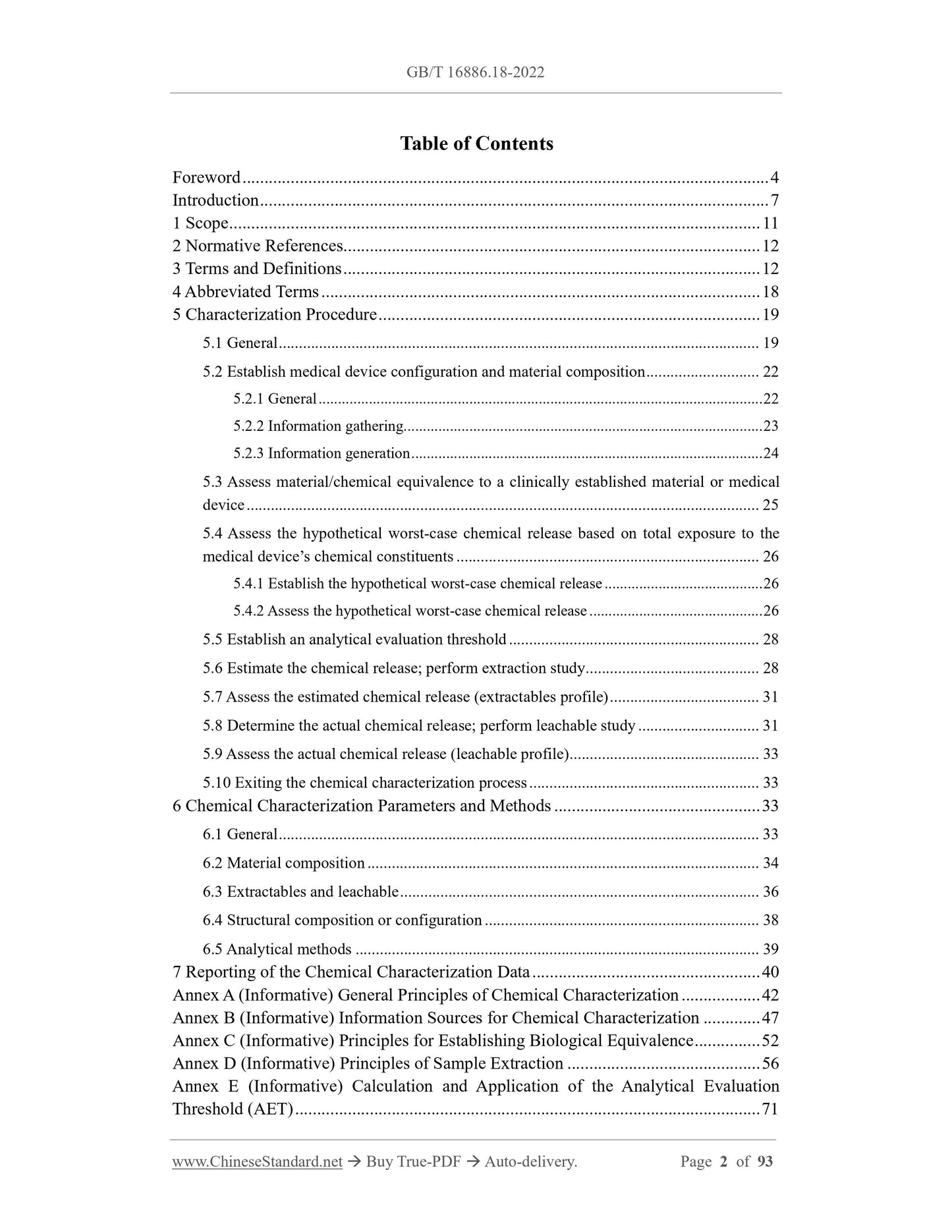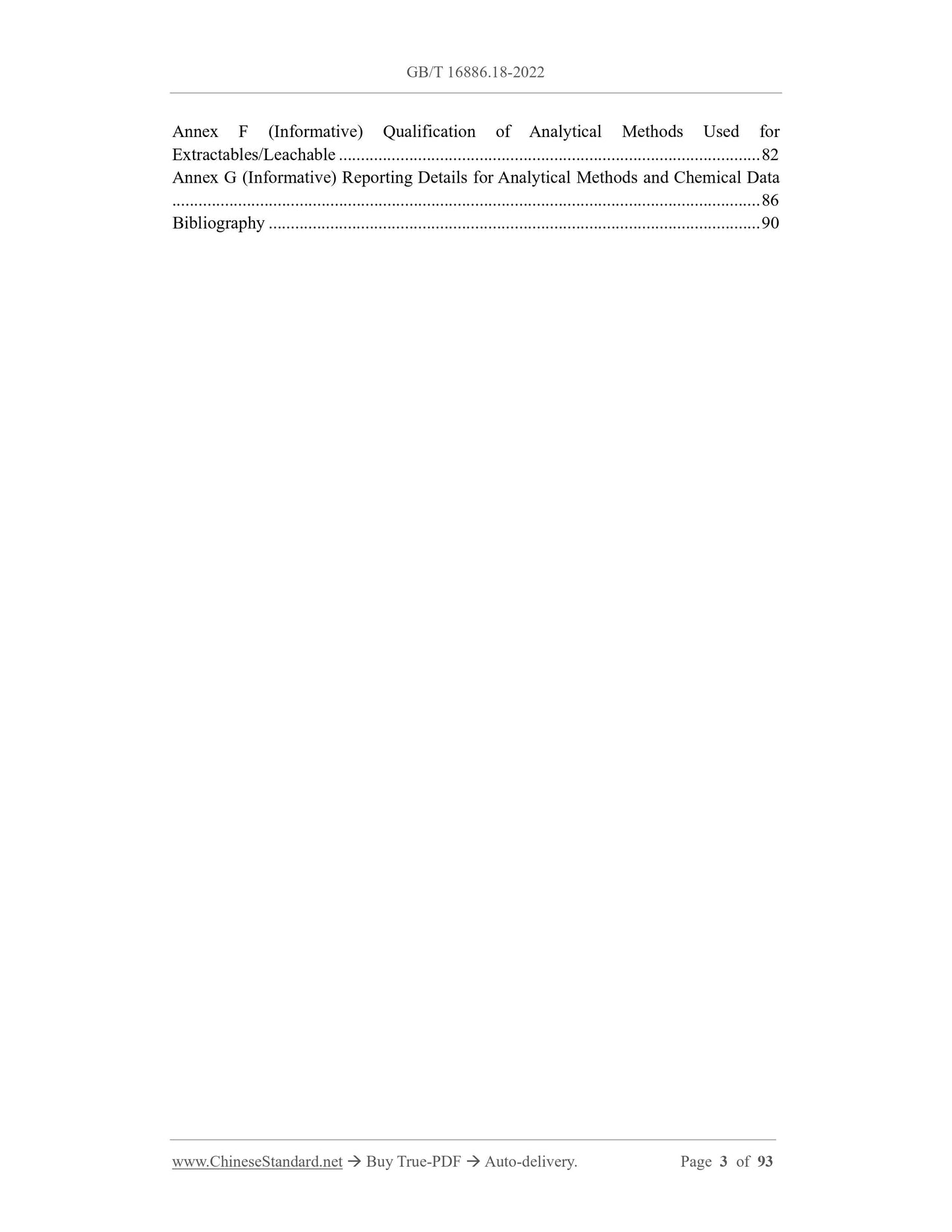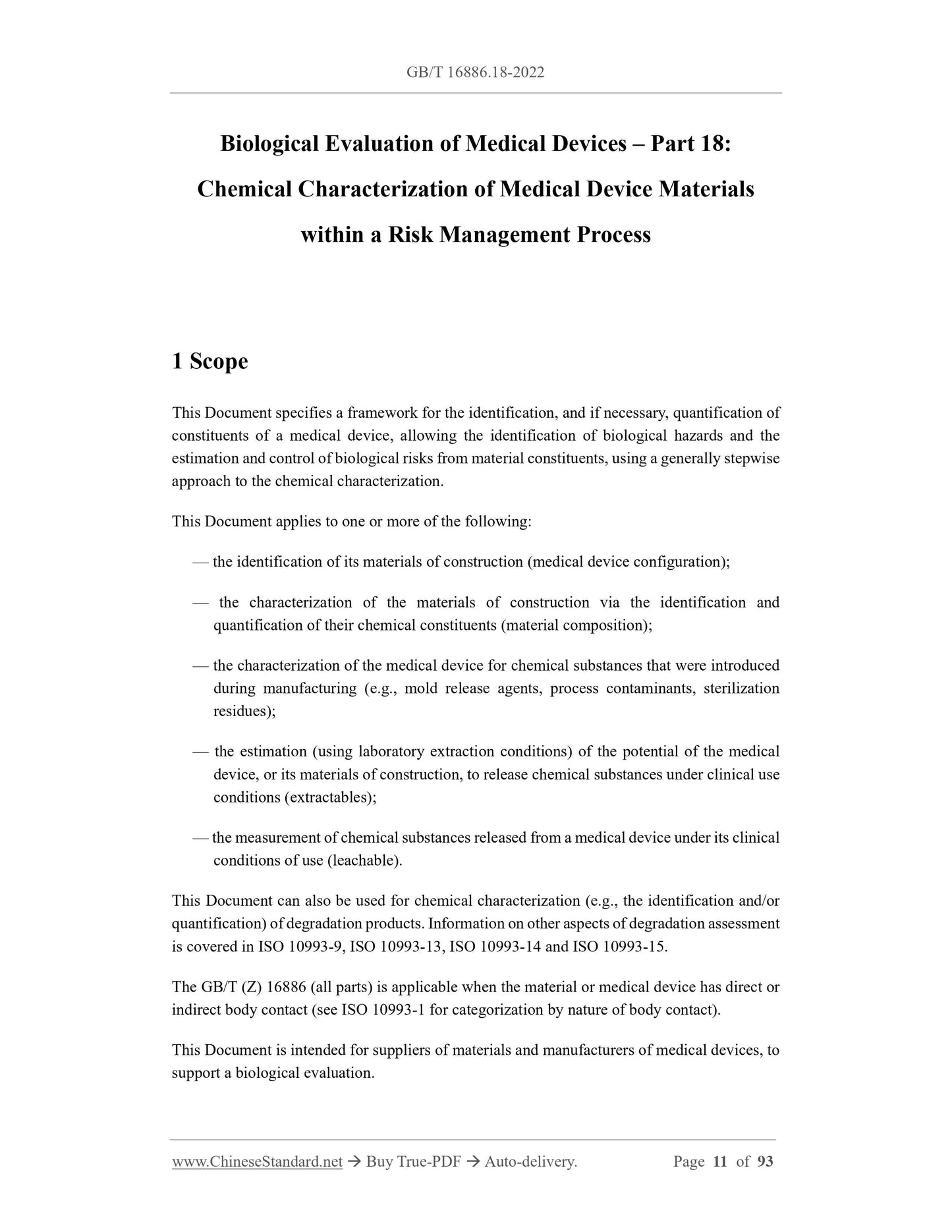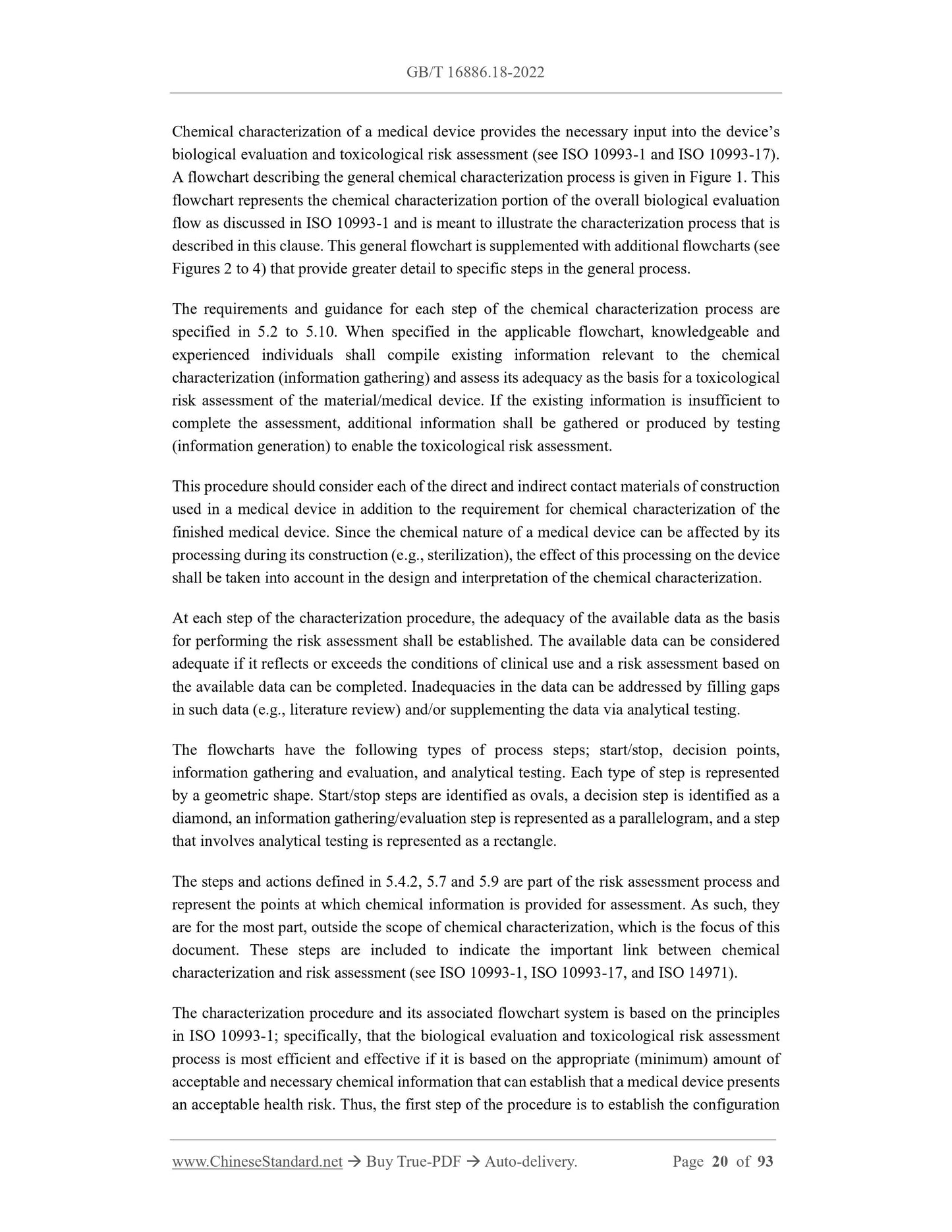PayPal, credit cards. Download editable-PDF and invoice in 1 second!
GB/T 16886.18-2022 English PDF (GBT16886.18-2022)
GB/T 16886.18-2022 English PDF (GBT16886.18-2022)
Precio habitual
$290.00 USD
Precio habitual
Precio de oferta
$290.00 USD
Precio unitario
/
por
Los gastos de envío se calculan en la pantalla de pago.
No se pudo cargar la disponibilidad de retiro
Delivery: 3 seconds. Download true-PDF + Invoice.
Get QUOTATION in 1-minute: Click GB/T 16886.18-2022
Historical versions: GB/T 16886.18-2022
Preview True-PDF (Reload/Scroll if blank)
GB/T 16886.18-2022: Biological evaluation of medical devices - Part 18: Chemical characterization of medical device materials within a risk management proces
GB/T 16886.18-2022
GB
NATIONAL STANDARD OF THE
PEOPLE’S REPUBLIC OF CHINA
ICS 11.100.20
CCS C 30
GB/T 16886.18-2022 / ISO 10993-18:2020
Replacing GB/T 16886.18-2011
Biological Evaluation of Medical Devices – Part 18:
Chemical Characterization of Medical Device Materials
within a Risk Management Process
(ISO 10993-18:2020, IDT)
化学表征
ISSUED ON: DECEMBER 30, 2022
IMPLEMENTED ON: JANUARY 01, 2024
Issued by: State Administration for Market Regulation;
Standardization Administration of the People’s Republic of China.
Table of Contents
Foreword ... 4
Introduction ... 7
1 Scope ... 11
2 Normative References ... 12
3 Terms and Definitions ... 12
4 Abbreviated Terms ... 18
5 Characterization Procedure ... 19
5.1 General ... 19
5.2 Establish medical device configuration and material composition ... 22
5.2.1 General ... 22
5.2.2 Information gathering ... 23
5.2.3 Information generation ... 24
5.3 Assess material/chemical equivalence to a clinically established material or medical
device ... 25
5.4 Assess the hypothetical worst-case chemical release based on total exposure to the
medical device’s chemical constituents ... 26
5.4.1 Establish the hypothetical worst-case chemical release ... 26
5.4.2 Assess the hypothetical worst-case chemical release ... 26
5.5 Establish an analytical evaluation threshold ... 28
5.6 Estimate the chemical release; perform extraction study ... 28
5.7 Assess the estimated chemical release (extractables profile) ... 31
5.8 Determine the actual chemical release; perform leachable study ... 31
5.9 Assess the actual chemical release (leachable profile) ... 33
5.10 Exiting the chemical characterization process ... 33
6 Chemical Characterization Parameters and Methods ... 33
6.1 General ... 33
6.2 Material composition ... 34
6.3 Extractables and leachable ... 36
6.4 Structural composition or configuration ... 38
6.5 Analytical methods ... 39
7 Reporting of the Chemical Characterization Data ... 40
Annex A (Informative) General Principles of Chemical Characterization ... 42
Annex B (Informative) Information Sources for Chemical Characterization ... 47
Annex C (Informative) Principles for Establishing Biological Equivalence ... 52
Annex D (Informative) Principles of Sample Extraction ... 56
Annex E (Informative) Calculation and Application of the Analytical Evaluation
Threshold (AET) ... 71
Annex F (Informative) Qualification of Analytical Methods Used for
Extractables/Leachable ... 82
Annex G (Informative) Reporting Details for Analytical Methods and Chemical Data
... 86
Bibliography ... 90
Biological Evaluation of Medical Devices – Part 18:
Chemical Characterization of Medical Device Materials
within a Risk Management Process
1 Scope
This Document specifies a framework for the identification, and if necessary, quantification of
constituents of a medical device, allowing the identification of biological hazards and the
estimation and control of biological risks from material constituents, using a generally stepwise
approach to the chemical characterization.
This Document applies to one or more of the following:
— the identification of its materials of construction (medical device configuration);
— the characterization of the materials of construction via the identification and
quantification of their chemical constituents (material composition);
— the characterization of the medical device for chemical substances that were introduced
during manufacturing (e.g., mold release agents, process contaminants, sterilization
residues);
— the estimation (using laboratory extraction conditions) of the potential of the medical
device, or its materials of construction, to release chemical substances under clinical use
conditions (extractables);
— the measurement of chemical substances released from a medical device under its clinical
conditions of use (leachable).
This Document can also be used for chemical characterization (e.g., the identification and/or
quantification) of degradation products. Information on other aspects of degradation assessment
is covered in ISO 10993-9, ISO 10993-13, ISO 10993-14 and ISO 10993-15.
The GB/T (Z) 16886 (all parts) is applicable when the material or medical device has direct or
indirect body contact (see ISO 10993-1 for categorization by nature of body contact).
This Document is intended for suppliers of materials and manufacturers of medical devices, to
support a biological evaluation.
Chemical characterization of a medical device provides the necessary input into the device’s
biological evaluation and toxicological risk assessment (see ISO 10993-1 and ISO 10993-17).
A flowchart describing the general chemical characterization process is given in Figure 1. This
flowchart represents the chemical characterization portion of the overall biological evaluation
flow as discussed in ISO 10993-1 and is meant to illustrate the characterization process that is
described in this clause. This general flowchart is supplemented with additional flowcharts (see
Figures 2 to 4) that provide greater detail to specific steps in the general process.
The requirements and guidance for each step of the chemical characterization process are
specified in 5.2 to 5.10. When specified in the applicable flowchart, knowledgeable and
experienced individuals shall compile existing information relevant to the chemical
characterization (information gathering) and assess its adequacy as the basis for a toxicological
risk assessment of the material/medical device. If the existing information is insufficient to
complete the assessment, additional information shall be gathered or produced by testing
(information generation) to enable the toxicological risk assessment.
This procedure should consider each of the direct and indirect contact materials of construction
used in a medical device in addition to the requirement for chemical characterization of the
finished medical device. Since the chemical nature of a medical device can be affected by its
processing during its construction (e.g., sterilization), the effect of this processing on the device
shall be taken into account in the design and interpretation of the chemical characterization.
At each step of the characterization procedure, the adequacy of the available data as the basis
for performing the risk assessment shall be established. The available data can be considered
adequate if it reflects or exceeds the conditions of clinical use and a risk assessment based on
the available data can be completed. Inadequacies in the data can be addressed by filling gaps
in such data (e.g., literature review) and/or supplementing the data via analytical testing.
The flowcharts have the following types of process steps; start/stop, decision points,
information gathering and evaluation, and analytical testing. Each type of step is represented
by a geometric shape. Start/stop steps are identified as ovals, a decision step is identified as a
diamond, an information gathering/evaluation step is represented as a parallelogram, and a step
that involves analytical testing is represented as a rectangle.
The steps and actions defined in 5.4.2, 5.7 and 5.9 are part of the risk assessment process and
represent the points at which chemical information is provided for assessment. As such, they
are for the most part, outside the scope of chemical characterization, which is the focus of this
document. These steps are included to indicate th...
Get QUOTATION in 1-minute: Click GB/T 16886.18-2022
Historical versions: GB/T 16886.18-2022
Preview True-PDF (Reload/Scroll if blank)
GB/T 16886.18-2022: Biological evaluation of medical devices - Part 18: Chemical characterization of medical device materials within a risk management proces
GB/T 16886.18-2022
GB
NATIONAL STANDARD OF THE
PEOPLE’S REPUBLIC OF CHINA
ICS 11.100.20
CCS C 30
GB/T 16886.18-2022 / ISO 10993-18:2020
Replacing GB/T 16886.18-2011
Biological Evaluation of Medical Devices – Part 18:
Chemical Characterization of Medical Device Materials
within a Risk Management Process
(ISO 10993-18:2020, IDT)
化学表征
ISSUED ON: DECEMBER 30, 2022
IMPLEMENTED ON: JANUARY 01, 2024
Issued by: State Administration for Market Regulation;
Standardization Administration of the People’s Republic of China.
Table of Contents
Foreword ... 4
Introduction ... 7
1 Scope ... 11
2 Normative References ... 12
3 Terms and Definitions ... 12
4 Abbreviated Terms ... 18
5 Characterization Procedure ... 19
5.1 General ... 19
5.2 Establish medical device configuration and material composition ... 22
5.2.1 General ... 22
5.2.2 Information gathering ... 23
5.2.3 Information generation ... 24
5.3 Assess material/chemical equivalence to a clinically established material or medical
device ... 25
5.4 Assess the hypothetical worst-case chemical release based on total exposure to the
medical device’s chemical constituents ... 26
5.4.1 Establish the hypothetical worst-case chemical release ... 26
5.4.2 Assess the hypothetical worst-case chemical release ... 26
5.5 Establish an analytical evaluation threshold ... 28
5.6 Estimate the chemical release; perform extraction study ... 28
5.7 Assess the estimated chemical release (extractables profile) ... 31
5.8 Determine the actual chemical release; perform leachable study ... 31
5.9 Assess the actual chemical release (leachable profile) ... 33
5.10 Exiting the chemical characterization process ... 33
6 Chemical Characterization Parameters and Methods ... 33
6.1 General ... 33
6.2 Material composition ... 34
6.3 Extractables and leachable ... 36
6.4 Structural composition or configuration ... 38
6.5 Analytical methods ... 39
7 Reporting of the Chemical Characterization Data ... 40
Annex A (Informative) General Principles of Chemical Characterization ... 42
Annex B (Informative) Information Sources for Chemical Characterization ... 47
Annex C (Informative) Principles for Establishing Biological Equivalence ... 52
Annex D (Informative) Principles of Sample Extraction ... 56
Annex E (Informative) Calculation and Application of the Analytical Evaluation
Threshold (AET) ... 71
Annex F (Informative) Qualification of Analytical Methods Used for
Extractables/Leachable ... 82
Annex G (Informative) Reporting Details for Analytical Methods and Chemical Data
... 86
Bibliography ... 90
Biological Evaluation of Medical Devices – Part 18:
Chemical Characterization of Medical Device Materials
within a Risk Management Process
1 Scope
This Document specifies a framework for the identification, and if necessary, quantification of
constituents of a medical device, allowing the identification of biological hazards and the
estimation and control of biological risks from material constituents, using a generally stepwise
approach to the chemical characterization.
This Document applies to one or more of the following:
— the identification of its materials of construction (medical device configuration);
— the characterization of the materials of construction via the identification and
quantification of their chemical constituents (material composition);
— the characterization of the medical device for chemical substances that were introduced
during manufacturing (e.g., mold release agents, process contaminants, sterilization
residues);
— the estimation (using laboratory extraction conditions) of the potential of the medical
device, or its materials of construction, to release chemical substances under clinical use
conditions (extractables);
— the measurement of chemical substances released from a medical device under its clinical
conditions of use (leachable).
This Document can also be used for chemical characterization (e.g., the identification and/or
quantification) of degradation products. Information on other aspects of degradation assessment
is covered in ISO 10993-9, ISO 10993-13, ISO 10993-14 and ISO 10993-15.
The GB/T (Z) 16886 (all parts) is applicable when the material or medical device has direct or
indirect body contact (see ISO 10993-1 for categorization by nature of body contact).
This Document is intended for suppliers of materials and manufacturers of medical devices, to
support a biological evaluation.
Chemical characterization of a medical device provides the necessary input into the device’s
biological evaluation and toxicological risk assessment (see ISO 10993-1 and ISO 10993-17).
A flowchart describing the general chemical characterization process is given in Figure 1. This
flowchart represents the chemical characterization portion of the overall biological evaluation
flow as discussed in ISO 10993-1 and is meant to illustrate the characterization process that is
described in this clause. This general flowchart is supplemented with additional flowcharts (see
Figures 2 to 4) that provide greater detail to specific steps in the general process.
The requirements and guidance for each step of the chemical characterization process are
specified in 5.2 to 5.10. When specified in the applicable flowchart, knowledgeable and
experienced individuals shall compile existing information relevant to the chemical
characterization (information gathering) and assess its adequacy as the basis for a toxicological
risk assessment of the material/medical device. If the existing information is insufficient to
complete the assessment, additional information shall be gathered or produced by testing
(information generation) to enable the toxicological risk assessment.
This procedure should consider each of the direct and indirect contact materials of construction
used in a medical device in addition to the requirement for chemical characterization of the
finished medical device. Since the chemical nature of a medical device can be affected by its
processing during its construction (e.g., sterilization), the effect of this processing on the device
shall be taken into account in the design and interpretation of the chemical characterization.
At each step of the characterization procedure, the adequacy of the available data as the basis
for performing the risk assessment shall be established. The available data can be considered
adequate if it reflects or exceeds the conditions of clinical use and a risk assessment based on
the available data can be completed. Inadequacies in the data can be addressed by filling gaps
in such data (e.g., literature review) and/or supplementing the data via analytical testing.
The flowcharts have the following types of process steps; start/stop, decision points,
information gathering and evaluation, and analytical testing. Each type of step is represented
by a geometric shape. Start/stop steps are identified as ovals, a decision step is identified as a
diamond, an information gathering/evaluation step is represented as a parallelogram, and a step
that involves analytical testing is represented as a rectangle.
The steps and actions defined in 5.4.2, 5.7 and 5.9 are part of the risk assessment process and
represent the points at which chemical information is provided for assessment. As such, they
are for the most part, outside the scope of chemical characterization, which is the focus of this
document. These steps are included to indicate th...
Share
